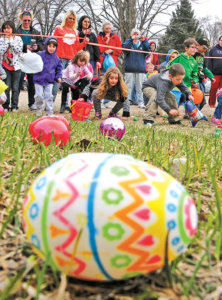 They arrive on the supermarket shelves pretty much as soon as the Christmas tinsel is cleared away – whole shelves full of gleaming, tempting, foil-wrapped chocolate eggs, guaranteed to blow any New Year resolutions out of the water.
They arrive on the supermarket shelves pretty much as soon as the Christmas tinsel is cleared away – whole shelves full of gleaming, tempting, foil-wrapped chocolate eggs, guaranteed to blow any New Year resolutions out of the water.
So what is it with chocolate and Easter? How did we come to celebrate a religious festival by bingeing on cocoa products?
Well, the now-defunct confectionery company JS Fry of Bristol (remember their iconic Fry’s Chocolate Cream?) was responsible for making the first chocolate egg in the UK, way back in 1873, with Cadbury’s launching their version two years later.
Decorated by hand to suit Victorian tastes, these eggs were made from dark chocolate and would have been rather grainy and bitter by today’s standards, according to Cadbury’s. They would also have been a very expensive and luxury gift – not the pocket money mass market products we see today.
It was in 1905 that Cadbury’s launched its Dairy Milk chocolate bar, and the subsequent Easter egg made with this new-style milk chocolate proved a big hit with the confectionery-loving public.
Better transportation, a lowering of trade tariffs on cocoa, and developments in production allowed the masses to enjoy Easter eggs – although at that time, adults rather than children were still the target market.
Fast-forward to 2017, and approximately 80 million chocolate Easter eggs were sold in the UK, with the average child consuming eight chocolate eggs, according to research. Britain’s chocolate egg and Easter confectionery sales will total a belt-busting £200 million.
Prior to the hi-jacking of Easter by the chocolate industry, the festival was celebrated with much simpler customs, although eggs still featured strongly as a symbol of re-birth.
Real eggs – in most cases, chicken eggs – were hard-boiled and dyed in various colors and patterns. The traditionally bright colours represented spring and light, and mothers and children would enjoying painting or dyeing them in preparation for Easter Sunday. Sadly, nowadays if you gave a child in Britain a hard-boiled egg on Easter Sunday, you would probably end up wearing it!
In an older tradition, real eggs would be rolled against one another or down a hill, and the owner of the egg that stayed uncracked the longest would be declared the winner. Even today in the north of England, the custom of egg rolling is still a popular celebration of a simpler kind of Easter, with hard- boiled eggs being enthusiastically rolled down slopes to see whose egg goes furthest. Typically everyone repairs to the local pub to celebrate the egg rolling champ.
Whether you plan to celebrate Easter with a chocolate binge, a charming egg hunt for the kidlets or a bit of rolling of the hard-boiled variety down a handy slope, you’ll be doing it rather earlier this year: Good Friday falls on March 30 and Easter Sunday on April 1st. Last year Easter fell in the middle of April.
This quirk of timing is because Easter traditionally is observed on the first Sunday after the first full moon following the first day of spring in the Northern Hemisphere. Got that? Yes, it’s complicated! This means that the festival can occur on any Sunday between March 22 and April 25. Not only is Easter the end of the winter, but it also marks the end of Lent, traditionally a time of fasting in the Christian calendar.
Hence its reputation as a season of fun and celebration.
So head on out and enjoy the silliness of Easter bonnets and egg-rolling, painting funny faces on your breakfast eggs – and loosening the belt to take on board a bit of chocolate!



